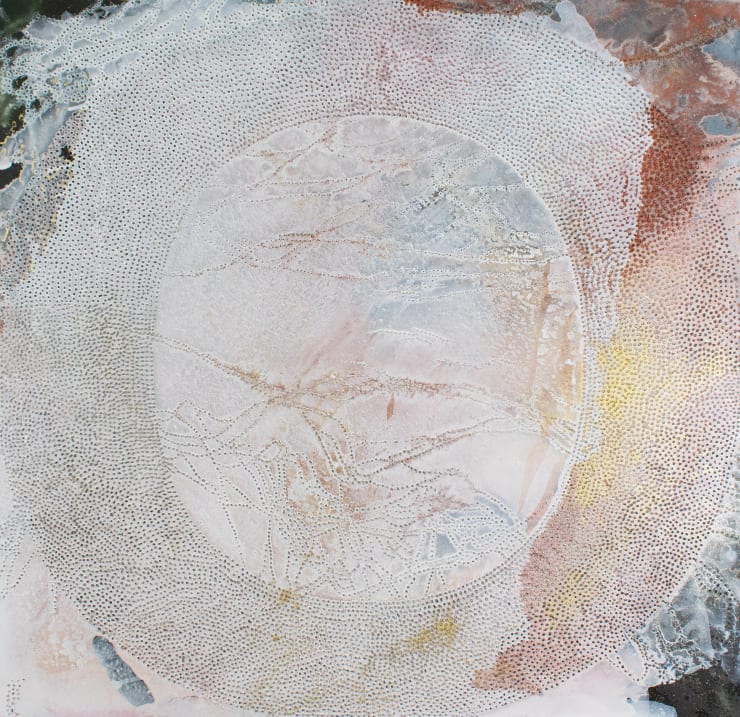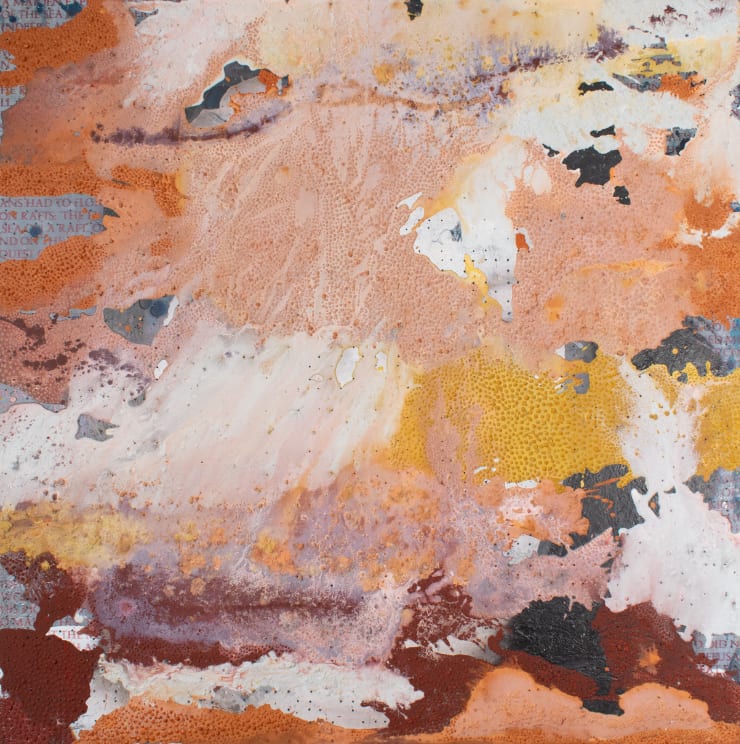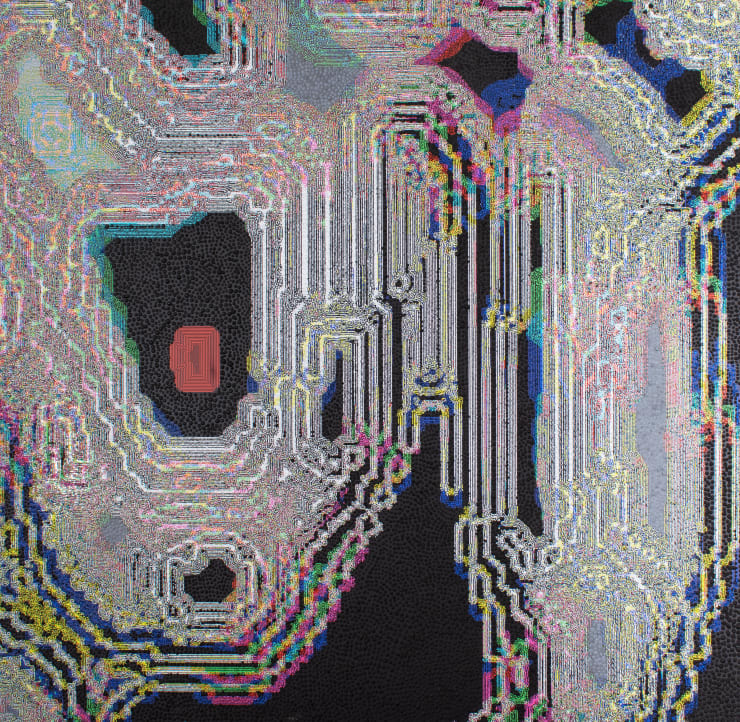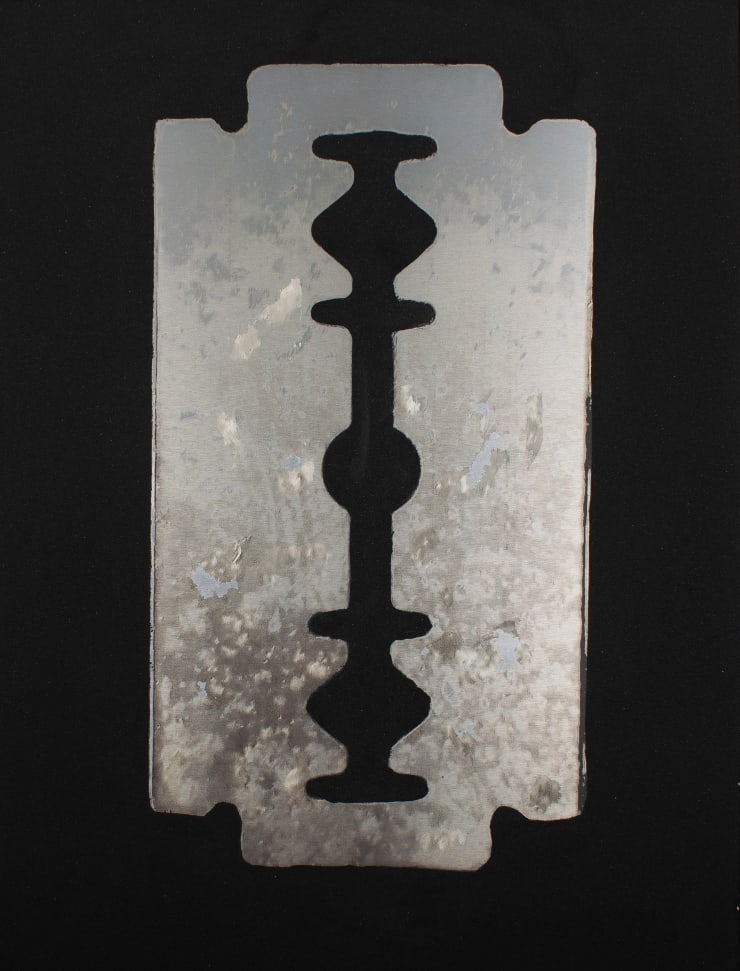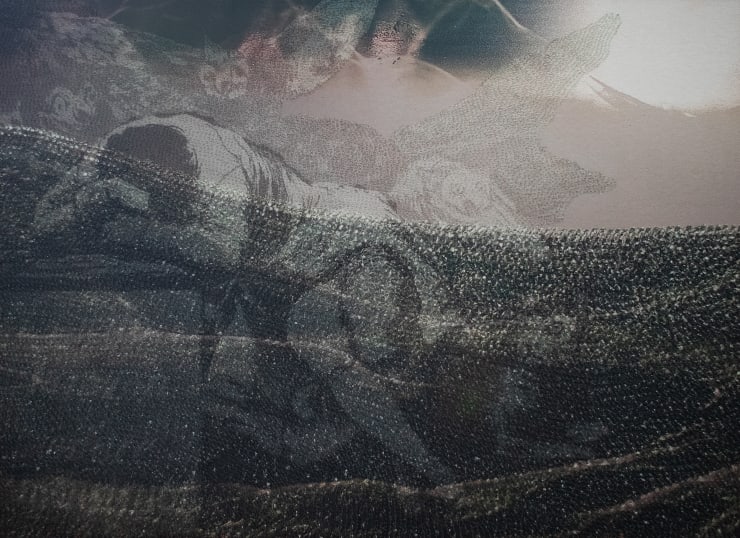IMMERSION III
-
 Peter PanyoczkiReconstituting Plato’s Shadow, 2024Mixed media on aluminium120 x 120 cm
Peter PanyoczkiReconstituting Plato’s Shadow, 2024Mixed media on aluminium120 x 120 cm -
 Peter PanyoczkiTectonic Shift of Narration 1, 2024Mixed media on aluminium120 x 120 cm
Peter PanyoczkiTectonic Shift of Narration 1, 2024Mixed media on aluminium120 x 120 cm -
 Peter PanyoczkiPolarization, 2024Mixed media on copper154 x 124 cm
Peter PanyoczkiPolarization, 2024Mixed media on copper154 x 124 cm -
 Peter PanyoczkiEARTH, 2024Mixed media on aluminium180 x 180 cm
Peter PanyoczkiEARTH, 2024Mixed media on aluminium180 x 180 cm -
 Peter PanyoczkiFingerprints, 2024Mixed media on aluminium108 x 158 cm
Peter PanyoczkiFingerprints, 2024Mixed media on aluminium108 x 158 cm -
 Peter PanyoczkiTectonic Shift of Narration 5, 2024Mixed media on aluminium120 x 120 cm
Peter PanyoczkiTectonic Shift of Narration 5, 2024Mixed media on aluminium120 x 120 cm -
 Peter PanyoczkiMother Earth, 2023Mixed media on aluminium158 x 128 cm
Peter PanyoczkiMother Earth, 2023Mixed media on aluminium158 x 128 cm -
 Peter PanyoczkiCandle, 2024Mixed media on aluminium158 x 128 cm
Peter PanyoczkiCandle, 2024Mixed media on aluminium158 x 128 cm -
 Peter PanyoczkiBath Time with Alchimedes - Drowning in Tears No. 2, 2024Mixed media on aluminium108 x 158 cm
Peter PanyoczkiBath Time with Alchimedes - Drowning in Tears No. 2, 2024Mixed media on aluminium108 x 158 cm -
 Peter PanyoczkiNOSCE TE IPSUM - Know Thyself, 2024Mixed media, steel, LED lights & fencing masks60 x 120 cm
Peter PanyoczkiNOSCE TE IPSUM - Know Thyself, 2024Mixed media, steel, LED lights & fencing masks60 x 120 cm -
 Peter PanyoczkiMy Throbbing Heart, 2023Mixed media on aluminium158 x 128 cm
Peter PanyoczkiMy Throbbing Heart, 2023Mixed media on aluminium158 x 128 cm -
 Peter PanyoczkiFlame - Digitalized, 2024Mixed media on aluminium120 x 120 cm
Peter PanyoczkiFlame - Digitalized, 2024Mixed media on aluminium120 x 120 cm -
 Peter PanyoczkiPLANET, 2024Mixed media & black sand on aluminium120 x 120 cm
Peter PanyoczkiPLANET, 2024Mixed media & black sand on aluminium120 x 120 cm -
 Peter PanyoczkiOckham’s Razor , 2024Mixed media & black sand on aluminium128 x 98 cm
Peter PanyoczkiOckham’s Razor , 2024Mixed media & black sand on aluminium128 x 98 cm -
 Peter PanyoczkiParthenogenesis, 2024Mixed media on aluminium180 x 180
Peter PanyoczkiParthenogenesis, 2024Mixed media on aluminium180 x 180 -
 Peter PanyoczkiNOSCE TE IPSUM - SKIN & BORDERLINE, 2024Jeans fabric covered with mixed media.
Peter PanyoczkiNOSCE TE IPSUM - SKIN & BORDERLINE, 2024Jeans fabric covered with mixed media.
Felt hat covered with mixed media, wood.
112 x 55 x 8 cm -
 Peter Panyoczki“IL SUEÑO DE LA RAZON PRODUCE MONSTRUOS”, 2024Mixed media on aluminium106 x 141 cm
Peter Panyoczki“IL SUEÑO DE LA RAZON PRODUCE MONSTRUOS”, 2024Mixed media on aluminium106 x 141 cm -
 Peter PanyoczkiLife Lines, 2023Mixed media on aluminium158 x 128 cm
Peter PanyoczkiLife Lines, 2023Mixed media on aluminium158 x 128 cm -
 Peter PanyoczkiTHE INVENTION OF THE WHEEL, 2024Mixed media on wood and steel136 x 63 x 12 cm
Peter PanyoczkiTHE INVENTION OF THE WHEEL, 2024Mixed media on wood and steel136 x 63 x 12 cm -
 Peter PanyoczkiTHE BOOK OF BEGINNINGS, 2023Mixed media on paper and wood31 x 24 x 19 cm
Peter PanyoczkiTHE BOOK OF BEGINNINGS, 2023Mixed media on paper and wood31 x 24 x 19 cm
"Existence is enigmatic. The events around us are inexplicable. There are obstacles in our way. More than ever, it seems to me, we actually want to avoid them. It affects our concept of life, which is always shaken by external things. Fundamental doubts arise, including our future, the future of humanity: politics is out of control, the basis of life is at risk.
Art wants to get behind the covering of the opaque, to make the hidden visible, to show the pain...or to make it bearable. Will art make it? What do I do as an artist? I want to dive in to finding visual metaphors for these numerous levels that we encounter.
IMMERSION will be my theme. This is the third and final part of my IMMERSION series this year. I hope to resurface with more clarity, and put a different, at least a flimsy light on some issues.
I exhibit work that is aesthetically and technically diverse, that perhaps contradicts one another, non-representational and figurative, just as our path is not straight. I also deviate, sense new possibilities that I merely hint at, going back in my history and forward. I would like to invite the viewer to immerse into their own thoughts. My works in the context of an exhibition should function as elements of 'words in a poem', as in a Haiku, weaving their own multi-layered narrative."
- Peter Panyoczki 2024
Fears about art and technology, and in particular the emergence of artificial intelligence – the so-called age of the “post-human” – have given rise to concerns about the future of painting yet again. What can artists do? Peter Panyoczki, as a painter who has been working on the international stage for decades, continues to address what it means to be human and make art with this third iteration of his Immersion series.
Rather than shy away from the cultural convergence of art, science and technology, he embraces it, and deploys his skills to comment on the state of the world. In his unique painting language, he refers to electrical wave lengths, the 2.7 Kelvin residue of the Big Bang which is the cosmic microwave background (CMB), a radiation field of “white noise” that provides a snapshot of the universe shortly after the Big Bang. Even though existing technologies don’t allow us to see the moment of the universe’s creation as a single hot and dense spot expanded, CMB shows us the "echo" of the expansion, and Panyoczki imagines it. Here, made manifest in paint, is the primordial soup theory - the hypothesis that life on Earth began in a mixture of water and organic compounds that accumulated in early Earth's oceans.
Dot art or “pixel pushing” has been a feature of painting practice since the advent of digital imaging. Everyone is now familiar with how a low-resolution image when blown up will distort and start to lose coherence. This pixelation happens when the individual pixels that make up an image become visible, resulting in a blocky and distorted appearance. Simulating this is Panyoczki’s deliberate artistic choice, making pixelation into a metaphor to question reality and experience. Just as at the end of the nineteenth century Impressionists broke up their brushstrokes to incorporate new understandings of the science of vision and create a fresher effect through optical mixing of small dabs of colour adjacent to each other, so in the twenty-first century, the digital realm offers insights to how the brain processes an image through the visual information provided. While there are superficial similarities to Aboriginal art, this is not what is being emulated, although the artist sees a connection conceptually in the way in which Songlines connect with the knowledges of ancient predecessors.
Another metaphor which the artist uses is braille, a form of written language for blind people, in which characters are represented by patterns of raised dots that are felt with the fingertips. Here dots have been rearranged into meaningful messages such as the Universal Declaration of Human Rights, Article One: “All human beings are born free and equal in dignity and rights”. The declaration also states that all humans are endowed with reason and conscience and should treat each other in a spirit of brotherhood. Drafted after World War II and adopted by the United Nations General Assembly on December 10, 1948, this declaration was influenced by earlier initiatives, such as those of the International Labour Organisation (ILO), and was based on the Charter of the United Nations. New Zealand played a key role in the drafting of the declaration, led by Prime Minister Peter Fraser. Yet, as we can see with the situation in the Ukraine and Middle East, the principles of this Declaration have now been forgotten. By using braille to present it afresh in his work, the artist shows how we are the ones who are blind now. Glass beads provide the means by which to read the signs, as shown in this text by Oscar Wilde, from Humanitad:
But we have left those gentle haunts to pass
With weary feet to the new Calvary,
Where we behold, as one who in a glass
Sees his own face, self-slain Humanity,
And in the dumb reproach of that sad gaze
Learn what an awful phantom the red hand of man can raise.
In the way in which he critiques the current global political and environmental situation, Panyoczki shows how artists can act as the seismographs of the status quo. To explain what he perceives as the existing state of affairs, especially regarding social or political issues, the artist points to the second law of thermodynamics which states that the entropy of an isolated system will increase over time. Perhaps that system is Capitalist Realism, as the author Mark Fisher has defined it: “…the widespread sense that not only is capitalism the only viable political and economic system, but also that it is now impossible even to imagine a coherent alternative to it.” Entropy is the general trend of the universe toward death and disorder with the degradation of the matter and energy in the universe to an ultimate state of inert uniformity.
Some of these paintings refer to images from art history such as Goya’s aquatint, The Sleep of Reason Produces Monsters (1797) or specific theories such as Occam's razor, a principle named after William of Ockham, a 14th-century logician and theologian. The razor is the instrument for distinguishing between two hypothetical explanations for a phenomenon. It can be used to "shave away" unnecessary assumptions or cut apart two similar conclusions. Fundamentally, it means that the simplest explanation is preferable to a more complex one. Panyoczki takes this theory into painting, as his byline for simplifying complicated things. This idea can be used to explain why his work hovers between representation and abstraction, often aided by investigations of the digital realm. Consider the image of a flame photographed and then increased in size until you start to see the code for the way that the computer works to make the image. You begin to see the abstract pattern made by the wiring of the computer. In this way he shows that the analogue and digital realms are two sides of the same coin. Similarly abstraction and realism is can be understood as part of the same continuum or different viewpoints of the same phenomenon.
Another painting refers to Archimedes’s famous eureka moment watching his bath water get displaced and the level rise as he entered his tub. From this simple observation, Archimedes derived his principle – the first condition of equilibrium - that a body immersed in a fluid is subjected to an upwards force equal to the weight of the displaced fluid. In Panyoczki’s rendition of displacement theory, it is tears that are filling up the bath tub which aesthetically transforms. Yet there are hidden layers of meaning in the work, and only one may be the narration of the references which are at play. One analogy is the way that words can be put together as a poem, yet they can be exchanged or swapped about and then the poem would have another meaning. In order to offer the viewer multiple connotations, the artist presents his paintings like haiku poems for contemplation. Words often appear as the substrate in the paintings, concealed beneath a topography of paint over the surface; they can be used to construct contrary narratives.
There have been tectonic shifts of narrative for the artist himself. In 2021 he had a stroke. During the recovery period, he was reminded of a dream he had when he was 21 years old and in Edinburgh, having seen Roman Polanski's 1971 film adaptation of Macbeth which was filmed at Lindisfarne Castle in Northumberland, England. That night he dreamt that he entered a cave, and saw the three witches from Shakespeare’s play. They told him something very important but when he awoke what he had learnt was gone. In a similar way, the stroke had erased some knowledge and left him with a different sense of self. Nosce Te Ipsum (Know Yourself), the philosophical maxim which was inscribed upon the Temple of Apollo in the ancient Greek precinct of Delphi, became an important touch stone. Fingerprints – the most reliable way to identify individuals – are a symbol of uniqueness, and a tool of self-identification for the artist too. His interest has also turned to the representation of the throbbing heart – painting the electrical pulses that cause the heart's muscles to contract, which pumps blood throughout the body.
Immersion, as Panyoczki shows us in this exhibition can be an intellectually stimulating process. It is mentally absorbing, and can be a slow process as one follows the passage from one mental state to another. While immersed, our critical distance from what is being shown is diminished, and we experience increased emotional involvement in what is happening. Whatever the future of technologies brings, it will never supplant the potential of a human painter to communicate and to continue to create new ways for us to see.
- Linda Tyler
Art Historian, The University of Auckland.

